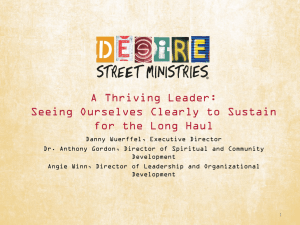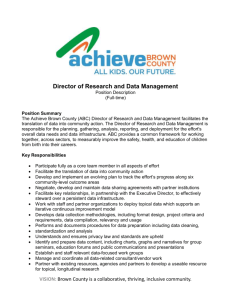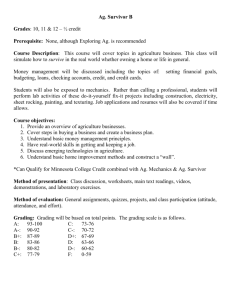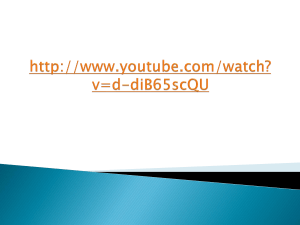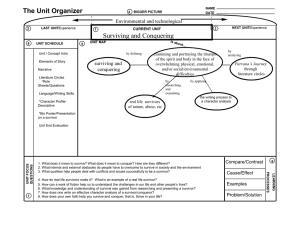Thriving in a Survivor World - Vanderbilt University Medical Center
advertisement
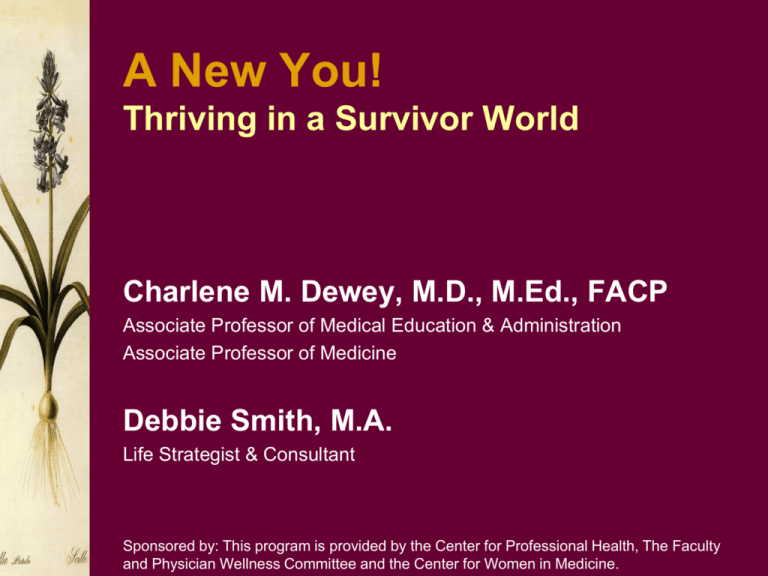
A New You! Thriving in a Survivor World Charlene M. Dewey, M.D., M.Ed., FACP Associate Professor of Medical Education & Administration Associate Professor of Medicine Debbie Smith, M.A. Life Strategist & Consultant Sponsored by: This program is provided by the Center for Professional Health, The Faculty and Physician Wellness Committee and the Center for Women in Medicine. Conflict of Interest Sponsored by Vanderbilt School of Medicine; Department of Office of Teaching and Learning in Medicine. Vanderbilt School of Medicine is accredited by the Accreditation Council for Continuing Medical Education to provide continuing medical education for physicians. Vanderbilt School of Medicine designates this educational activity for a maximum of 2.0 AMA PRA Category 2 Credit(s)TM. Physicians should only claim credit commensurate with the extent of their participation in the activity. It is the policy of Vanderbilt School of Medicine that participants in CME activities be made aware of any affiliation or financial interest that may affect the planner’s involvement and speaker’s presentation(s). Each planner and speaker has completed and signed a conflict of interest statement; these relationships will be disclosed to the audience. Charlene Dewey and Debbie Smith has NO financial relationships to disclose. Goals ♀ The overall purpose of this series is to assist women faculty and employees with focusing on their wellness and prioritizing themselves to the top of their “to do” list as part of their new years resolution. ♀ Four-part series – focused on YOU! Objectives During session 1 participants will: ♀ Self-reflect on the challenges I face as a woman including prioritizing my personal well-being. ♀ Identify with the analogy of the thriving plant. ♀ List the areas I feel I can focus on for the next 12 months. ♀ Discuss the evidence for the need to care for my personal well-being. ♀ Recognize what I can take control of in order to improve my personal well-being. Agenda ♀ ♀ ♀ ♀ Introduction Review of what’s known Thriving or surviving Summary & evaluations Please select your appropriate title or position 1. 2. 3. 4. 5. 6. Physician Scientist Nurse Administrator Employee Other 52% 16% 12% 8% 8% 4% 1 2 3 4 5 6 How much training have you had on creating and maintaining your personal 36% well-being? 32% lo t A So m lit t e 16% le 16% A None A little Some A lot No ne a. b. c. d. On a scale of 1 (lowest) – 9 (highest), where do you prioritize your personal well-being? 23% 1. 2. 3. 4. 5. 6. 7. 8. 9. One Two Three Four Five Six Seven Eight Nine 19% 15% 15% 15% 8% 4% 0% 1 2 0% 3 4 5 6 7 8 9 On a scale of 1 (not satisfied – 7 (completely satisfied), how satisfied are you with both your personal and work-life? 29% 1. 2. 3. 4. 5. 6. 7. Not satisfied x x x x x Completely Satisfied 21% 21% 14% 11% 4% 0% 1 2 3 4 5 6 7 I can discuss the risk factors for stress and burnout. 67% 1. True 2. False 3. I don’t know 33% tk no w Id on ’ Fa ls e Tr ue 0% I am currently at burnout. 48% 1. 2. 3. 4. 48% Strongly agree Disagree Agree Strongly agree 4% 0% 1 2 3 4 Overall, on a day to day basis, rank how you are doing? 45% a. Near crashing b. Barely surviving c. Well-balanced if there are no emergencies d. Thriving 38% 10% 7% a. b. c. d. “The first wealth is health.” ~ Ralph Waldo Emerson Mind Body Soul Stress & Burnout ♀ Stress can be defined as: • d : a state resulting from a stress; especially : one of bodily or mental tension resulting from factors that tend to alter an existent equilibrium <job-related stress> Webster’s dictionary ♀ Burnout can be defined as: • a : exhaustion of physical or emotional strength or motivation usually as a result of prolonged stress or frustration b : a person suffering from burnout. Webster’s dictionary Stress & Burnout ♀ Stress and burnout occurs for different reasons in different individuals. ♀ Work load ≠ level of stress or burnout. ♀ Multifactorial Burnout “In the current climate, burnout thrives in the workplace. Burnout is always more likely when there is a major mismatch between the nature of the job and the nature of the person who does the job.” ~Christina Maslach The Truth About Burnout: How Organizations cause Personal Stress and What to Do About It. Maslach & Leiter pg 9; 1997 Six Sources of Burnout 1. 2. 3. 4. 5. 6. Work overload Lack of control Insufficient reward Unfairness Breakdown of community Value conflict Maslach & Leiter, 1997. “The Truth About Burnout: How Organizations Cause Personal Stress and What to Do About It.” Symptoms of Burnout The first signs of burnout: 1. You become chronically exhausted 2. You become cynical and detached from your work 3. You feel increasingly ineffective in your job 4. Leads to: Isolation; Avoidance; Interpersonal conflicts & High turnover Maslach & Leiter, 1997. “The Truth About Burnout: How Organizations Cause Personal Stress and What to Do About It.” pg 17 Risk Factors for Burnout ♀ ♀ ♀ ♀ ♀ ♀ Single Gender/sexual orientation ># of children at home Family problems Mid-late career Previous mental health issues (depression) ♀ ♀ ♀ ♀ ♀ ♀ Fatigue & sleep deprivation General dissatisfaction Alcohol and drugs Minority/international Teaching & research demands Potential litigation Puddester D. West J Med 2001;174:5-7; Myers MJ West J Med 2001;174:30-33 Gautam M West J Med 2001;174:37-41 The Truth About Women in Health Care Women in Health Care ♀ Women make up the majority of the health care industry4 ♀ Women physicians more prone to anxiety, stress, depression in the workplace2,3 ♀ Women MD more likely to commit suicide1 ♀ Women ≠ Men: http://www.youtube.com/watch?v=P77JnDHUw6g 1. 2. 3. http://www.nimh.nih.gov/health/publications/suicide-in-the-us-statistics-and-prevention/index.shtml Health of Faculty in Academic Medicine, 2009 http://www.adaa.org/about-adaa/press-room/facts-statistics 4. U.S. Department of Labor, Bureau of Labor Statistics, Employment and Earnings, 2008 Annual Averages and the Monthly Labor Review, November 2007. Vanderbilt Resources Abbrev. Program Focus Contact Number FPWC Faculty and Physician Wellness Committee All issues of professional health Charlene Dewey x6-0678 FPWP Faculty and Physician Wellness Program – Work/Life Connections EAP Treatment & counseling for faculty and employees Mary Yarbrough X6-1327 CPH Center for Professional Health Training physicians Bill Swiggart x6-0678 VCAP Vanderbilt Comprehensive Assessment Program for Professionals Fit for duty assessments and treatment Reid Finlayson X2-4567 CPPA Center for Patient and Professional Advocacy Identification and assistance Jerry Hickson X3-4500 The Truth About Burnout “The twin goals of preventing and building engagement are possible and necessary in today’s working world. These goals cannot be easily achieved by an individual. Rather, people have to work together to make them happen. And if we all commit ourselves to the long-term process of organizational progress, we will be rewarded with workplaces that are more productive and resilient as well as humane.” ~Maslach & Leiter, pg 127 Thriving in a Survivor World Living is like gardening Thriving in a Survivor World Who will be the SURVIVOR? The Cycle of Survival Anxiety about future Expectations/responsibilities from others Exhaustion/Feel trapped Scrambling to perform Anxiety about performance Thriving in a Survivor World “Leaders rise to power in our society by operating very competently and effectively in the external world, sometimes at the cost of internal awareness…I have met many leaders whose confidence in the external world is so high that they regard the inner life as illusory, as a waste of time, as a magical fantasy trip into a region that doesn’t even exist… Thriving in a Survivor World “…Of course, leaders are supported in this by an American culture that wants to externalize everything, that wants…to see the good life as a matter of outer arrangements rather than of inner wellbeing.” --Parker Palmer Thriving in a Survivor World Self-Awareness “Self-awareness means having a deep understanding of one’s emotions, strengths, weaknesses, needs, and drives. People with strong self-awareness are neither overly critical nor unrealistically hopeful. Rather, they are honest – with themselves and with others.” “What Makes a Leader?” by Daniel Goleman, Best of Harvard Business Review (1998) Thriving in a Survivor World Investing Life vs. Spending Days Thriving in a Survivor World Where Are You? Surviving……………..Thriving Thriving in a Survivor World What is Thriving? Embracing the truth of who you are so that you can freely receive, give and hope, regardless of your circumstances. --Debbie Smith, M.A. Thriving in a Survivor World A New You Overview ♀ ♀ ♀ ♀ Tending your core (Desires & Gifts) Weeding the garden (Beliefs) Cultivating strong roots (Values) Receiving nourishment in every season Thriving in a Survivor World Tending your “core” Desires/Dreams Gifts/Motivated Abilities Thriving in a Survivor World Thriving in a Survivor World Thriving in a Survivor World Motivated Abilities Natural abilities which come easily, are enjoyable to do, and result in a sense of inner satisfaction and meaningfulness. --Nick Isbister Thriving in a Survivor World Motivated Abilities ♀ You come alive (creating life) ♀ You are moved to tears (destroying injustice) Thriving in a Survivor World Motivated Abilities ♀ Skill – can be learned/acquired ♀ Motivated Ability – natural, no one ever taught you to do it Colors REDExercise BLUE WHITE YELLOW GREEN PINK RED GREEN WHITE PURPLE RED GREEN PINK GREEN ORANGE RED BLUE RED YELLOW WHITE GREEN RED PINK Thriving in a Survivor World Motivated Abilities “Vocation does not come from willfulness. It comes from listening…Vocation does not mean a goal that I pursue. It means a calling that I hear. Before I can tell my life what I want to do with it, I must listen to my life telling me who I am.” --Parker Palmer Thriving in a Survivor World Desires & Motivation INTENTION vs. REACTION Thriving in a Survivor World Motivated Abilities ♀ Life stories – things you DO… -Sense of ease -Enjoyment -Satisfaction/meaningfulness Thriving in a Survivor World Summary “The quest for balance lacks the notion that life is to be given to something bigger than ourselves.” --John Ortberg Thriving in a Survivor World Summary Balance – focuses on external world Congruence – focuses on connecting inner world with external world Thriving in a Survivor World Chinese Symbol for “Busy” “Heart” and “Killing” Thriving in a Survivor World “Above all else guard your heart,, for it is the wellspring of life.” --Proverb Thriving in a Survivor World Thriving in a Survivor World < Beautiful Blossoms < Free from weeds < Well-nourished < Awareness of “core” < Strong roots Session 1 Summary ♀ Women predominate in the health care system ♀ You are unique and need to focus your priority on you first. ♀ Continue your reflection and planning to take actions to thrive and not just survive. ♀ Session 2 is planned for April 2010
